Risk Prioritization 101: What Is It, Levels, and Strategies
As a product manager, you’re in the hot seat for quite a bit: Juggling schedules, steering projects, and aligning teams. But there’s one accountability that probably causes more stress than the others combined:
Risk.
You landed on this piece because you’ve got risks breathing down your neck with limited hours in the day and finite resources at your disposal. So without beating around the bush, in this article, we’ll answer these burning questions:
- What’s risk prioritization? It boils down to separating the ‘deal-with-now’ from ‘can-kick-down-the-road’ risks.
- Why give it attention? Treating every flicker of danger as an inferno isn’t just impractical; it saps your team dry.
- And what’s in store for you here? A straight shot from Risk Prioritization 101 to crafting a matrix that’ll keep those potential fires orderly.
What is Risk Prioritization?
Risk prioritization is essentially about figuring out which risks could hit your project the hardest and are more likely to happen.
Think of it this way: As a product manager, you’re not just on the lookout for problems, you’ve got to play favorites with them too.
You juggle different types of issues like pesky bugs or unpredictable market trends.
It’s not about trying to cut risk out of the picture completely (let’s be real, that’s never going to happen) but rather managing these risks in an intelligent way.
Your job is to make sure you focus your time and budget on the right problem spots.
The 4 Factors of Risk Prioritization
As product managers, we’ve got to play the odds and think about damage control. Here’s what you should have on your radar:
- Impact: Look at how much risk could mess things up, like throwing wrenches in your timeline, inflating budgets like a balloon, or making your product do backflips when it should be sprinting straight. Keep an eye out for the big troublemakers; they’re usually worth tackling first.
- Probability: You don’t need a crystal ball here but use your detective skills to figure out if these risks are really going to crash the party or just no-shows blowing smoke. Dig through what happened before (because history loves reruns), check out what’s buzzing right now, and maybe get some intel from folks who eat risk for breakfast to see if you’re worrying over nothing.
- Resource Availability: Take a good look at what you’ve got in the tank. Got enough people power, tech gurus, and hours in the day? You need a solid grasp on whether or not you can actually take on this risk without causing problems elsewhere.
- Timing: When is this problem going to hit? Some risks are breathing down your neck, and others might be off chilling in the distance for now. The key thing is knowing which ones will force you into firefighting mode right away versus those that give you a bit more time for some thoughtful scheming.
Getting these two factors straight helps tailor how we deal with unwanted surprises. It’s about being smart where our effort goes so we don’t drop the ball on bringing our A-game plan from paper sketches all the way through launch day.
How to Calculate Risk Priority Numbers?
Let’s strip this down to the nuts and bolts of calculating Risk Priority Numbers (RPN).
Think of it as a way to decide which fires need your extinguishing efforts first. You’re going to use a simple multiplication here:
RPN = Impact x Probability x Detectability
- Impact: How bad is it if this risk shows up uninvited at your project party? Score from 1 (a mere hiccup) to 10 (full-on project Armageddon).
- Probability: What are the odds of this unwelcome guest actually showing up? Again, score from 1 (probably never) to 10 (get ready with confetti because it’s almost certain).
- Detectability: Can you spot the trouble early on, or is it more like finding a needle in a haystack? Score between 1 (you’ve got eagle eyes) and 10 (basically invisible).
Once all risks have their numbers crunched, higher RPNs wave red flags saying, “deal with me first!” So keep those high-scorers close; they’ll guide where you focus your defenses.
Alright, let’s break it down with an example using Fibery.
Imagine we’re dependent on a supplier for a key part, and there’s this cloud of worry that they might not deliver on time.
The fallout from this hiccup could be pretty rough, think significant business interruption. So here we tag the impact as 8 out of 10.
Now, how likely is this mess to happen? We’re pegging it at a 4, it’s in the realm of possibility but don’t bet your lunch money on it just yet.
And spotting this trouble before it hits us? Tricky but doable: give that detectability factor a score of 3.
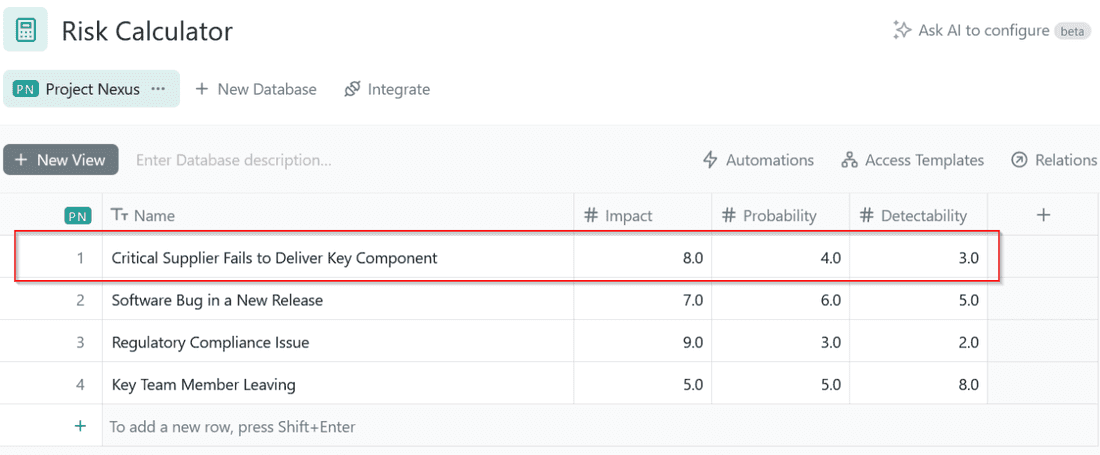
Time for some quick math:
Risk Priority Number (RPN) = Impact (8) × Probability (4) × Detectability (3), which gives us RPN = 96
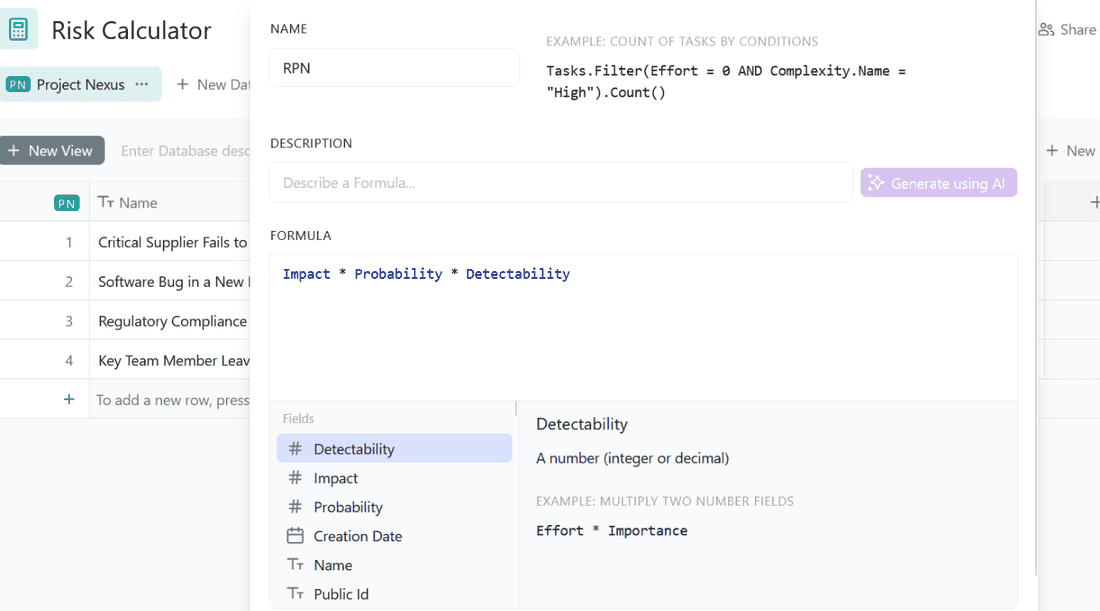
A score like that is our cue to sit up straight and get moving; we’ve got serious risk brewing here.
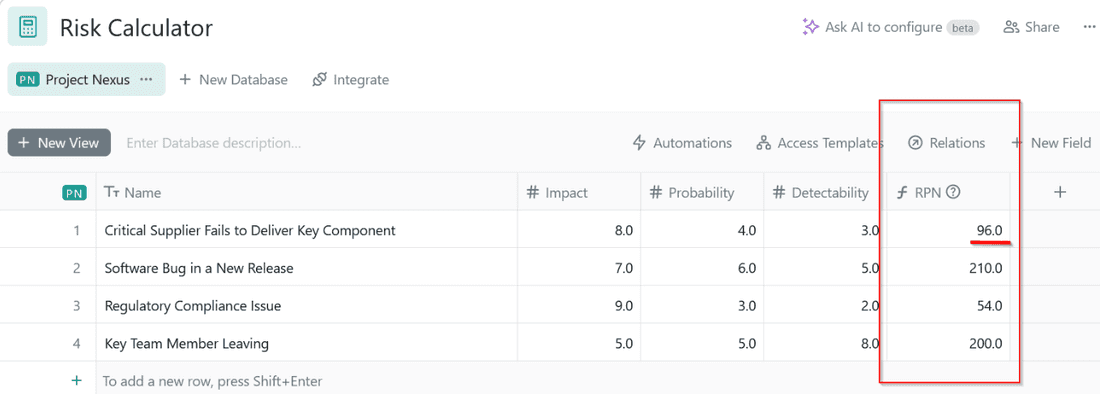
By figuring out these RPNs across the board, product managers can line up their defense strategies smartly, tackling big-ticket risks head-on while still keeping an eye on smaller risks nipping at their budget heels.
The 4 Levels of Risk Prioritization
Without sounding like an algorithm, let’s break down the 4 levels of risk into categories that make sense to PMs:

- At the top, you’ve got your “Extreme” risks. These are non-negotiables that you need to tackle head-on, and fast. If you don’t, they have the potential to take your project down faster than a house of cards in a windstorm.
- One step down is “High” risk. They’re not red-alert critical, but don’t put them on ice for too long or they might just freeze over into bigger headaches. Keep an eye out and have strategies ready to roll.
- “Moderate” risks align in the middle. You’ve got some breathing room here as the sky isn’t falling (yet), but treat these guys right within your usual workflow so they don’t get any wild ideas about causing trouble.
- Then there’s “Low.” These are essentially the quiet ones that could be ignored but shouldn’t be. After all, even small things can snowball when given half a chance. Check on these occasionally to ensure everything stays cool and collected.
The 3 Strategies for Risk Prioritization
For a tighter risk management operation, here’s what you need to do:
- Regular Risk Reviews: Lock in these meetings every week or two. Your goal? Stay on top of the game and make sure nothing risky has snuck up on you since last time. Keep your eyes peeled and manage those existing threats like a pro, this keeps surprises at bay and your project humming along smoothly.
- Engage Your Team: Don’t go solo; risk management is a team sport. Tap into the smarts all around you for spotting, sizing up, and tackling risks head-on. Get everyone throwing ideas around. It’s like finding hidden gems that could speed things up big time when it comes to squashing risks before they blow up.
- Embrace Tech Tools: Get those purpose-built risk management applications working for you. They’re not just shiny toys; they come packed with features that sort stuff into ‘urgent’ and ‘not now,’ without breaking a sweat.
By nailing down these strategies, you’re setting yourself up for a solid defense when projects go sideways (because let’s face it; sometimes they do). Keep things under control and ride out the storms like a pro.
How to Create a Risk Prioritization Matrix
Nailing down your risk prioritization matrix is an essential puzzle piece in keeping potential project pitfalls on your radar. Let’s walk through setting one up:
- Identify Potential Risks: Kick things off by identifying every conceivable risk that might throw a wrench into the works of your project.
- Evaluate Each Risk: Whip out the Risk Priority Number (RPN) tactic to assess each risk. You’ll be scoring them based on how much of a headache they could cause, their likelihood, and whether you’d see them coming.
- Sort Risks: Shuffle each identified threat into its rightful spot within the matrix depending on its RGP scorecard. Think of it as seating arrangements at an event, but instead of people, it’s all about gauging impact versus chances of showing up uninvited.
- Flag Top Concerns: Those pesky risks lounging in the ‘Big Trouble, Probably Happening’ quadrant? They’re essentially waving red flags at you. It’s time for action now rather than later.
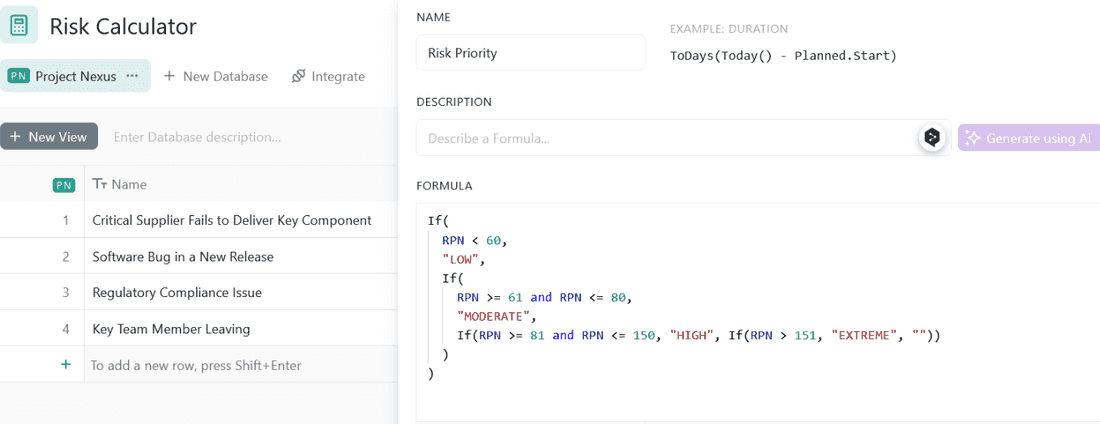
Remember our Fibery example? By slipping some clever formulas into play here, levels of risk can be automatically sorted into the matrix.
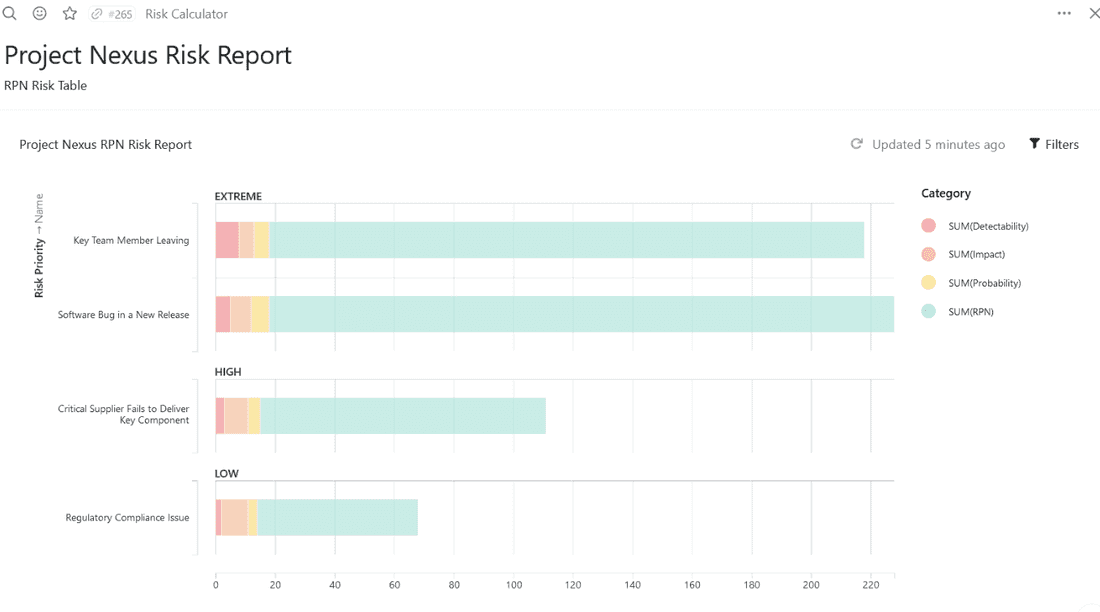
How to Prioritize Risks
Managing risks wisely is about staying flexible and keeping your project on track, even when unexpected issues pop up. Here’s a clear outline to help you handle this process smoothly:
Identify
Start by pinpointing the most serious risks using your risk prioritization matrix. Look for those in the ‘extreme’ zone, as the consequences of their occurrence are severe and more likely to happen.
By doing this, you ensure that nothing threatening slips through the cracks.
Assess
As your product continuously evolves, so do the risks. Keep an eye on these risks as things change in your project. A tweak here or shift there could shake up what you’re dealing with.
Staying sharp means you can update how risky something is and keep ahead of it all.
Mitigate
For each identified high or unacceptable risk, develop an approach that’s suited just for it. Take stock of what you’ve got at hand, how bad things might get, and how fast they need fixing when deciding your move.
Once the mitigation plans are formulated, then go out there and put those plans into action.
Monitor and Adapt
This is one of the most overlooked steps.
Don’t just set actions in motion and forget about them. Keep tabs on whether what you’re doing is working out or not, and be ready to switch gears based on new insights or outcomes from earlier steps.
In short, it’s essential to identify and tackle risks methodically. Start by spotting and understanding these potential challenges. Then, work out ways to reduce their impact and keep an eye on them as you move forward. This approach will set you up with a strong advantage. You and your team will be able to manage anything unexpected down the line with greater ease.
Every one of these steps builds a solid plan that protects your project goals and strengthens its ability to bounce back from setbacks.
Conclusion
Prioritizing risks is all about being ready for what comes your way. It might not be the highlight of a product manager’s day but do it well, and you’re in control. You will be not just juggling tasks but truly leading your products to success.
Keep in mind that you don’t need to tackle every single risk head-on; instead, focus on handling the unpredictable aspects of developing a product with careful thought.
Let this guide serve as your toolset—helping you make wiser decisions without exerting unnecessary effort.
Impressed by what you’ve seen? Give Fibery a try with our 14-day trial—no cost, no credit card required.
And if your appetite for prioritization tactics is still unsatisfied, hop over to the Fibery blog. It’s where product management pros share real wisdom—not just theories.
Psst... Wanna try Fibery? 👀
Infinitely flexible product discovery & development platform.